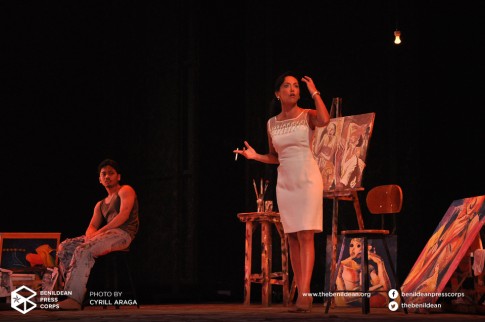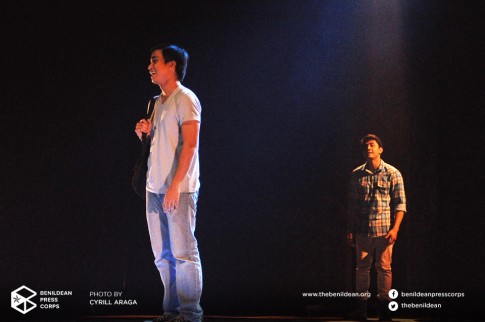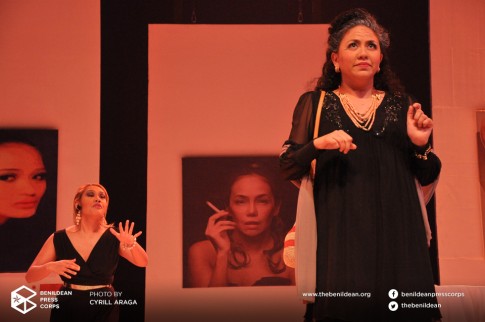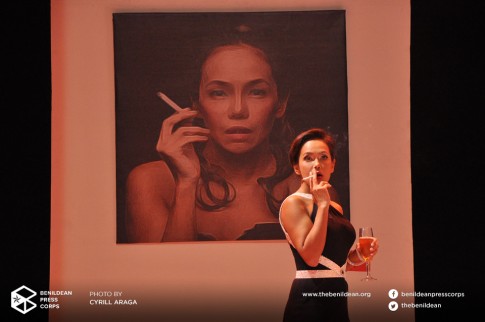It seems the only way to start this review is to acknowledge – and praise – the Technical Theater Program Batch 111 students of Benilde for having dared and successfully staged and produced 2014’s Fluid. Were the technical aspects of the production the only point, then this was quite a successful theatrical debut for this batch of students.
It would also, for the most part, be a successful re-write for contemporary times, something that playwright Floy Quintos talks about in his notes for the production. One is reminded by this re-write that many things about art making and production in this country continue to be true 10 years hence. Many things might need re-writing, but the system itself just evolves into viciousness, or devolves into the superficiality that capital demands.
The transformation of the Mira (Ana Abad Santos)-Amir (Kalil Almonte) relationship into a May-December affair is an interesting layer to the artist-art collector relationship – which of course can now only be layered by the role that a publicist / publicity plays in “making” the artist. In Fluid 2014, Mira and Amir as such are not only different in terms of their place in the art world, but in the fact of their age, their social class, their ideologies. What holds them together is art – and sex – and nothing else. Abad Santos’s Mira has the kind of discreet cunning that is in the art collector / investor of the present, which allowed for the cougar sexuality to be more complex. Almonte’s Amir meanwhile seemed far from being the jologs artist he was supposed to be. He looked too clean, too fit; his diction was inconsistent and that was crucial to becoming the extreme opposite of Mira.

The relationship between theater actors Jom (JC Santos) and Alben (Russel Legaspi) was also rewritten for Fluid 2014, and it was the funniest of the three stories here. While it would be easy to speak of the relationship to be merely a debate between fame and integrity, what is even more interesting is how it pokes fun at the current state of local theater, where there is a clear line drawn between what interests English theater companies, and Tagalog ones. Jom dreams of fame via starring in the musical Rent, his looks and mannerisms – and his English! – the perfect jab at the dime-a-dozen Pinoy English theater actor. Alben as counterpoint speaks English with a thick Filipino accent, is tall and moreno, and is one to imagine the wonder in the new Filipino translation of a Shakespearean text.
Santos and Legaspi do justice to the banter that needed to be swift, the ribbing that needed to balance sweetness and razor-sharp critique. These two were characters familiar and new, but Legaspi outdid most anybody else on that stage in his unraveling, where he did not only do wrong diction succinctly, but also wore the embarrassment and nerve, shame and confidence all at once. I would watch Fluid again just to see this version of Alben.

The relationship between Orchestra coordinator Renata (Amihan Ruiz) and events coordinator Simone (Gel Basa) is one that was not rewritten, and which fit quite well in the narratives of the present. Renata encounters Simone at a wedding, where the Orchestra coordinator refuses to abide by the agreed musical program, and has the band do a different repertoire of her preferred classics. The comedy in the exchange between the two women is borne not just of their age difference, but more importantly of their different concerns: Simone is concerned about her clients, Renata is concerned about the music as art, as life.
While Basa’s Simone is funny enough, the character at this point also caricature: this is a stereotype of the Pinay go-getter, whose social skills are limited to uh, socializing, and is far from caring about creativity and manners. Relative to Ruiz’s Renata, Basa would’ve disappeared completely were her comedic timing not en pointe. Ruiz captures the age in Renata, not just in manner and looks, but more importantly in grace and spirit — it was just the right amount of nuttiness. When Renata gets lost in the music, one almost feels like an unwelcome audience to such a personal experience. When Simone returns and tears apart the cheque that was to be paid Renata and the orchestra, the older woman snaps back to reality. It’s that one reality of money after all that makes this world of art go round.
It must be said that after Act 1, Fluid 2014 already felt a bit long. But the setting of Act 2 was enough to keep me glued to my seat, waiting for the coming together of these six characters. At this point too, the one new character here, the actor / dancer (Anthony Falcon) that threads the scenes together in Act 1 became absolutely pointless. It also deemed him unnecessary for most of Act 1, seeing as Act 2 would be a culmination of all those disparate scenes anyway.

The setting of Act 2 was Amir’s exhibit – the one that Mira had promised; there was little change in both of them, save for the pressure of keeping appearances taking its toll on the artist. Simone is events coordinator, and is at the mercy of Mira; Alben is a waiter, having quit acting. Renata comes in as the art critic, who was Mira’s special guest – the one Simone is supposed to take care of and entertain. One of the portraits in the exhibit is that of Jom’s, now a local heartthrob, and in the closet.
The art exhibit as intersection for the six characters is interesting enough. While the actor-turned-waiter seems a tad bit too old, if not altogether trite, the transformation of Jom is contemporary pop culture enough to be fodder for comedy. Simone again practically disappears, even as she must be in charge of keeping the order with Mira, made difficult by the fact of a drunk artist mingling with guests.
The one person who ties this all together is Renata, whose work as critic is what brings her to the gallery, but also what allows her to speak to every “artist” here. She remembers one of Alben’s performances and speaks to him about it, inadvertently encouraging the waiter to go back to acting – again a bit trite. Mira considers Renata important as critic, Renata’s positive review a part of Mira’s job as art agent / patron. Amir as young artist trapped in the art system finds comfort in Renata’s understanding of his crisis. The conversations are short and sweet, the shifts from one relationship to another brisk, keeping all of it interesting without sacrificing clarity.
Things come to a head when Amir passes out on the floor of the gallery, and Mira is forced to improvise. She announces with aplomb that Amir sleeping is but part of the exhibit, he is making a statement about art, he is performing.

It was wonderful really, a finger pointed at the audience, that can only be complicit in these systems that victimize art, where it is mere backdrop, secondary to fame and money. It was great to have been laughing at the comedy of lives bound to these systems, only to find that the joke was on us as spectators, complicit because we will believe someone like Mira, labeling the drunk artist as performance artist. We will believe it hook line sinker.
Except that Fluid 2014 did not stop there. It gave Mira the time to do a monologue, the waiter to do his bit about being artist, and Amir coming out of his stupor to declare his freedom. As re-writings would have it, this last bit could’ve been written out altogether. Then it would’ve been a truly contemporary version of the same text from 2004, daring to discuss the state of art and the systems and capital that tie it down and tear it apart. Then it might have been able to make a bigger statement about what we’re all doing wrong, and how.
Then, Fluid 2014 would’ve been truly rewritten for the current (non-)artistic times.
Fluid was staged by the Technical Theater Program Batch 111 of the College of St. Benilde, mentored Jay Aranda and Sunshine Domine, on July 24 to 26, written and directed by Floy Quintos. All photos from the Benildean Press Corps.